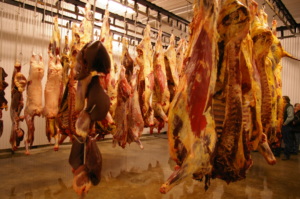In response to lawsuit, agency updates standards for first time in 20 years
WASHINGTON — Marking significant progress for clean water, the U.S. Environmental Protection Agency (EPA) proposed a new rule to curb pollution from meat and poultry processing plants on Friday. The new standards would reduce water pollution from the slaughterhouse sector by 100 million pounds per year, according to the EPA. The agency also presented alternatives that would achieve substantially greater reductions in slaughterhouse pollution.
“Today, the EPA took a major step towards reducing the massive flow of pollution that slaughterhouses dump into America’s rivers,” said John Rumpler, senior clean water director for Environment America. “If the agency follows through with a strong final rule, it will mark significant progress in reducing threats to wildlife and public health – including toxic algae, pathogens and nitrate contamination of drinking water sources.”
Meat and poultry processing plants release huge volumes of pollution to the nation’s waterways, as documented by Environment America Research & Policy Center’s fact sheet and map of slaughterhouse facilities.
Despite a Clean Water Act requirement to regularly update technology-based pollution standards (called “effluent limitation guidelines” or ELGs), the EPA has not done so for large slaughterhouse operations since 2004. Standards for smaller facilities were last set in 1975, and there are still no treatment standards for facilities that send their wastewater to sewage plants.
As a result of litigation brought by Environment America, Earthjustice, Environmental Integrity Project and several other organizations, the EPA committed to proposing new slaughterhouse ELGs by the end of 2023 and to finalize them by August 2025.
The standards proposed by EPA today would only apply to 845 of the 3879 meat and poultry processing plants that directly or indirectly release water pollution. The agency also outlined alternative standards that would reduce slaughterhouse pollution by more than two to three times as much as being proposed today.
“There’s no need to produce our food in ways that pollute our water,” Rumpler concluded. “By finally proposing to curb slaughterhouse pollution, the EPA is taking a crucial step towards fulfilling its mission to ensure clean water. We hope the agency will adopt a final rule that maximizes our chances for cleaner water across the nation – with rivers, lakes and streams that are safer for recreation, wildlife and our drinking water.”

Photo by Watershed Post via Flickr | CC-BY-2.0
